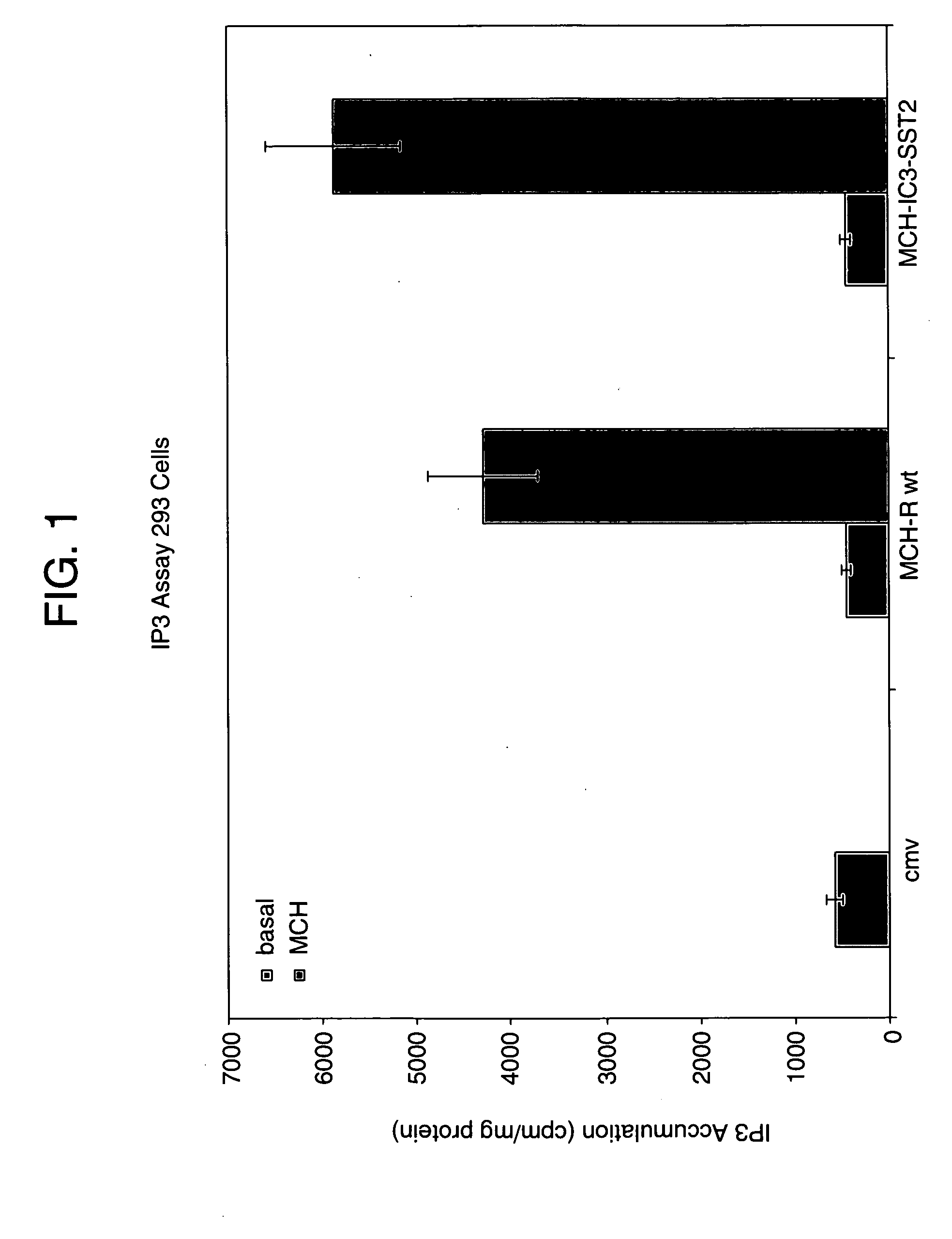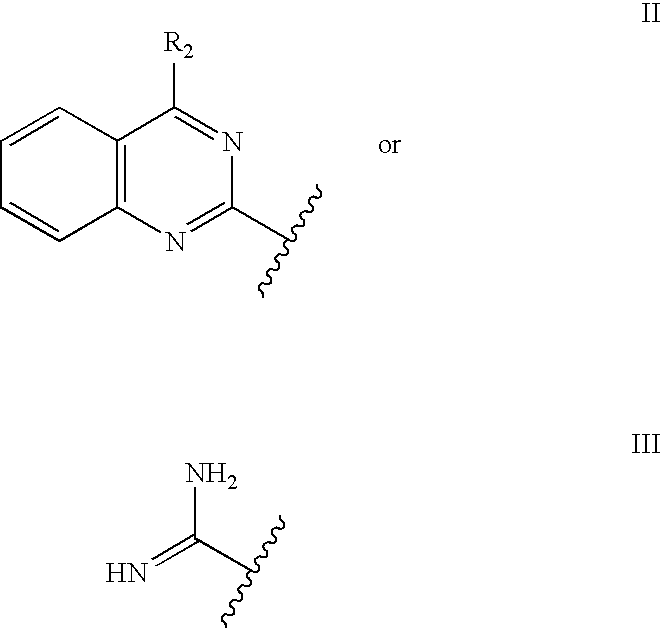Mch receptor antagonists
a technology of mch receptor and antagonist, which is applied in the field of mch receptor antagonists, can solve the problems of late-stage complications of diabetes and premature death, imbalance between energy intake and expenditure, and coronary artery diseas
- Summary
- Abstract
- Description
- Claims
- Application Information
AI Technical Summary
Problems solved by technology
Method used
Image
Examples
example 1
[3091]
trans-4-Bromo-N-{4-[(4-dimethylamino-quinazolin-2-ylamino)-methyl]-cyclohexylmethyl}-2-trifluoromethoxy-benzenesulfonamide
Step A: Synthesis of 2,4-dichloro-quinazoline
[3092] To a suspension of 1H-quinazoline-2,4-dione (150 g, 925 mmol) in POCl3 (549 mL, 5.89 mol) was added dimethyl-phenyl-amine (123 mL, 962 mmol). The mixture was stirred at reflux for 7 hr and concentrated. The solution was poured into ice water, and the aqueous layer was extracted with CHCl3 (three times). The combined organic layer was dried over MgSO4, filtered, concentrated, and purified by flash chromatography (silica gel, 50% CHCl3 in hexane to 10% EtOAc in CHCl3) to give 2,4-dichloro-quinazoline (159 g, 86%) as a pale yellow solid.
[3093] CI MS m / e 199, M+; 1H NMR (300 MHz, CDCl3) δ 8.27 (dt, J=8.3, 1.1 Hz, 1H), 7.95-8.04 (m, 2H), 7.71-7.81 (m, 1H).
Step B: Synthesis of (2-chloro-quinazolin-4-yl)-dimethyl-amine.
[3094] A solution of 2,4-dichloro-quinazoline (102 g, 530 mmol) in THF (1.2 L) was cooled ...
example 2
[3108]
trans-4-Bromo-N-{4-[(4-dimethylamino-quinazolin-2-ylamino)-methyl]-cyclohexylmethyl}-2-trifluoromethoxy-benzenesulfonamide hydrochloride
Step A: Synthesis of trans-4-bromo-N-{4-[(4-dimethylamino-quinazolin-2-ylamino)-methyl]-cyclohexylmethyl}-2-trifluoromethoxy-benzenesulfonamide hydrochloride
[3109] A solution of trans-4-bromo-N-{4-[(4-dimethylamino-quinazolin-2-ylamino)-methyl]-cyclohexylmethyl}-2-trifluoromethoxy-benzenesulfonamide obtained step H of example 1 (3.45 g, 5.61 mmol) in EtOAc (100 mL) was cooled on an ice-bath and 4 M hydrogen chloride in EtOAc (1.66 mL) was added. The mixture was stirred at ambient temperature for 1 hr and concentrated to give a white solid. The solid was recrystallized from 16% EtOH in Et2O, and dried under reduced pressure to give trans-4-bromo-N-{4-[(4-dimethylamino-quinazolin-2-ylamino)-methyl]-cyclohexylmethyl}-2-trifluoromethoxy-benzenesulfonamide hydrochloride (2.76 g, 75%) as a white solid.
[3110] ESI MS m / e 616, M+H+; 1H NMR (300 MHz,...
example 3
[3111]
trans-4-Bromo-N-9-{4-[(4-dimethylamino-quinazolin-2-ylamino)-methyl]-cyclohexyl}-2-trifluoromethoxy-benzenesulfonamide
Step A: Synthesis of trans-[4-(tert-butoxycarbonylamino-methyl)-cyclohexyl]-carbamic acid benzyl ester
[3112] To a suspension of trans-4-aminomethyl-cyclohexanecarboxylic acid (15.0 g, 95.4 mmol) in CHCl3 (150 mL) were added 1 M aqueous sodium hydroxide (150 mL) and (Boc)2O (21.9 g, 100 mmol) successively. The reaction mixture was stirred at ambient temperature for 15 hr, and partitioned between CHCl3 and water. The aqueous layer was acidified with saturated aqueous KHSO4 (pH=3), extracted with CHCl3 (three times). The combined organic layer was washed with brine, dried over MgSO4, filtered, and concentrated to give a white solid. To a suspension of the above solid in benzene (75 mL) were added phosphorazidic acid diphenyl ester (16.2 g, 58.9 mmol) and triethylamine (5.94 g, 58.7 mmol). The reaction mixture was stirred at reflux for 3 hr (Caution! Vigorous exo...
PUM
 Login to View More
Login to View More Abstract
Description
Claims
Application Information
 Login to View More
Login to View More - R&D
- Intellectual Property
- Life Sciences
- Materials
- Tech Scout
- Unparalleled Data Quality
- Higher Quality Content
- 60% Fewer Hallucinations
Browse by: Latest US Patents, China's latest patents, Technical Efficacy Thesaurus, Application Domain, Technology Topic, Popular Technical Reports.
© 2025 PatSnap. All rights reserved.Legal|Privacy policy|Modern Slavery Act Transparency Statement|Sitemap|About US| Contact US: help@patsnap.com



